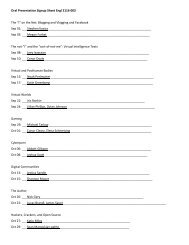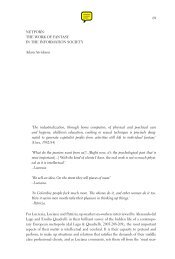Nakamura, Digitizing Race, Introduction, chapter 5, Epilogue
Nakamura, Digitizing Race, Introduction, chapter 5, Epilogue
Nakamura, Digitizing Race, Introduction, chapter 5, Epilogue
You also want an ePaper? Increase the reach of your titles
YUMPU automatically turns print PDFs into web optimized ePapers that Google loves.
180 Measuring <strong>Race</strong> on the Internet<br />
those people most likely to work as the “interacted” in the circuit of informatic<br />
labor.<br />
Members of Castells’s Fourth World are irrelevant to global flows of informatic<br />
power. Asian Americans are not members of this group. However, neither<br />
are they necessarily privileged digital model minorities. As Wendy<br />
Chun writes, “The Internet is not inherently oriental, but has been made oriental.”<br />
The ongoing cultural association with Asians and Asian Americans<br />
and high technologies is part of a vibrant and long-standing mythology. 21<br />
The most important development in terms of Internet users between<br />
2000 and 2005 is the radical increase in the number of women and ethnic<br />
and racial minorities online. In the early years of the Internet’s massification,<br />
cyberculture scholars discussed race online with only marginal references to<br />
online media and computer-mediated communications produced by blacks,<br />
Asians, and Latinos, instead focusing on representations of racial and ethnic<br />
minorities produced for consumption by white users and audiences. 22 Things<br />
have changed a great deal since then: English is no longer the majority language<br />
of the Internet, and vast numbers of new Asian users have made it inaccurate<br />
to speak of the Internet as a primarily Western medium. Cultural<br />
critics of new media as well as research foundations and policy organizations<br />
have much at stake in the way that race online is counted and tabulated.<br />
Neither are Asian American scholars free from bias when it comes to measuring<br />
Internet participation. There is much at stake in race-based measurement<br />
of Internet usage for them as well. As Lee and Wong note: “On the<br />
whole, scholars in the field of race and cyberspace remain critically hesitant<br />
to emphasize Asian Americans’ differences from other racial groups in terms<br />
of their cyberpractices, in part due to legitimate worries over the way such<br />
claims to distinction can play into old divide-and-conquer tactics that set<br />
minorities against (model) minorities.” 23 Scholars have strategically ignored<br />
Asian Americans as Internet power-users because this characterization separates<br />
them from other minority groups and implies that their priorities<br />
have more in common with the white majority. Unlike the Pew Internet<br />
and American Life Foundation, they are anxious to avoid characterizations<br />
of Asian Americans as a “digital majority.” Lee and Wong are right to emphasize<br />
the difficulties created by this strategy: if it is not possible to acknowledge<br />
Asian American advantages vis-à-vis Internet access, discussion<br />
of their cultural production is foreclosed. Even worse, representations of<br />
Asians as possessing “dangerous expertise” vis-à-vis the Internet because they<br />
are less disadvantaged than other minority groups exacerbate anti-Asian<br />
sentiment. 24 Reports that characterize Asians as more connected than whites





